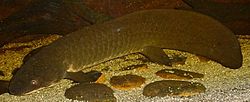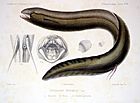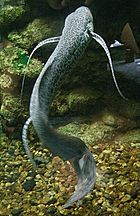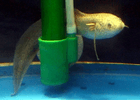Lungfish facts for kids
Quick facts for kids LungfishesTemporal range: Early Devonian - Recent
|
|
|---|---|
 |
|
| Queensland Lungfish | |
| Scientific classification | |
| Kingdom: | |
| Phylum: | |
| Subphylum: | |
| Class: | |
| Subclass: |
Dipnoi
J. P. Müller, 1844
|
| Orders | |
Lungfish are members of the subclass Dipnoi. They are a sister group to the Coelacanths and to the early lobe-finned fish which gave rise to the tetrapods. All these fish have paired appendages, fins or limbs, attached to a pelvis or shoulder by means of a single bone, the femur or humerus.
The living members of the group are special freshwater fish. They are the only living fish that have both lungs, as well as gills. They need this because they live in small lakes and rivers that sometimes dry up. When this happens, these fish don't die, but they can survive in the mud, for up to 4 years. They use their lungs during this time. This is called aestivation, which is a type of dormancy.
Currently there 8 species of lungfish, 6 of them in Africa, one in South America and one in Australia.
Extant lungfish
| Extant lungfishes | ||||
|---|---|---|---|---|
| Order | Family | Species | Image | Comments |
| Ceratodonti- formes |
Neocerato- dontidae |
Queensland lungfish | The Queensland lungfish, Neoceratodus forsteri, is endemic to Australia. Fossil records of this group date back 380 million years, around the time when the higher vertebrate classes were beginning to evolve. Fossils of lungfish almost identical to this species have been uncovered in northern New South Wales, indicating that the Queensland lungfish has remained virtually unchanged for well over 100 million years, making it a living fossil and one of the oldest living vertebrate genera on the planet. It is the most primitive surviving member of the ancient air-breathing lungfish (Dipnoi) lineages. The five other freshwater lungfish species, four in Africa and one in South America, are very different morphologically to N. forsteri. The Queensland lungfish can live for several days out of the water if it is kept moist, but will not survive total water depletion, unlike its African counterparts. | |
| Lepidosireni- formes |
Lepido- sirenidae |
South American lungfish |  |
The South American lungfish, Lepidosiren paradoxa, is the single species of lungfish found in swamps and slow-moving waters of the Amazon, Paraguay, and lower Paraná River basins in South America. Notable as an obligate air-breather, it is the sole member of its family Lepidosirenidae. Relatively little is known about the South American lungfish, or scaly salamander-fish. When immature it is spotted with gold on a black background. In the adult this fades to a brown or gray color. Its tooth-bearing premaxillary and maxillary bones are fused like other lungfish. South American lungfishes also share an autostylic jaw suspension (where the palatoquadrate is fused to the cranium) and powerful adductor jaw muscles with the extant lungfish (Dipnoi). Like the African lungfishes, this species has an elongate, almost eel-like body. It may reach a length of 125 centimetres (4.10 ft). The pectoral fins are thin and threadlike, while the pelvic fins are somewhat larger, and set far back. The fins are connected to the shoulder by a single bone, which is a marked difference from most fish, whose fins usually have at least four bones at their base; and a marked similarity with nearly all land-dwelling vertebrates. The gills are greatly reduced and essentially non-functional in the adults. |
| Proto- pteridae |
Marbled lungfish |  |
The marbled lungfish, Protopterus aethiopicus, is found in Africa. The marbled lungfish is smooth, elongated, and cylindrical with deeply embedded scales. The tail is very long and tapers at the end. They can reach a length of up to 200 cm. The pectoral and pelvic fins are also very long and thin, almost spaghetti-like. The newly hatched young have branched external gills much like those of newts. After 2 to 3 months the young transform (called metamorphosis) into the adult form, losing the external gills for gill openings. These fish have a yellowish gray or pinkish toned ground color with dark slate-gray splotches, creating a marbling or leopard effect over the body and fins. The color pattern is darker along the top and lighter below. The marbled lungfish has the largest known genome of any vertebrate, with 133 billion base pairs or building blocks in its DNA double helix. The only organisms known to have more base pairs are protist Polychaos dubium and flowering plant Paris japonica at 670 billion and 150 billion, respectively. | |
| Gilled lungfish |  |
The gilled lungfish, Protopterus amphibius is a species of lungfish found in East Africa. It generally reaches only of 44 cm (2 ft.) long, making it the smallest extant lungfish in the world. This lungfish is uniform blue, or slate grey in colour. It has small or inconspicuous black spots, and a pale grey belly. | ||
| West African lungfish |  |
The west African lungfish Protopterus annectens is a species of lungfish found in West Africa. It has a prominent snout and small eyes. Its body is long and eel-like, some 9-15 times the length of the head. It has two pairs of long, filamentous fins. The pectoral fins have a basal fringe and are about three times the head length, while its pelvic fins are about twice the head length. In general, three external gills are inserted posterior to the gill slits and above the pectoral fins. It has cycloid scales embedded in the skin. There are 40-50 scales between the operculum and the anus and 36-40 around the body before the origin of the dorsal fin. It has 34-37 pairs of ribs. The dorsal side is olive or brown in color and the ventral side is lighter, with great blackish or brownish spots on the body and fins except on its belly. They reach a length of about 100 cm in the wild . |
||
| Spotted lungfish |
The spotted lungfish, Protopterus dolloi, is a species of lungfish found in Africa. Specifically, it is found in the Kouilou-Niari Basin of the Republic of the Congo and Ogowe River basin in Gabon. It is also found in the lower and Middle Congo River Basins. Protopterus dolloi can aestivate on land by surrounding itself in a layer of dried mucus. It can reach a length of up to 130 cm. |
|||
Images for kids
-
Lateral view of lungs of a dissected spotted lungfish (Protopterus dolloi)
See also
 In Spanish: Peces pulmonados para niños
In Spanish: Peces pulmonados para niños






